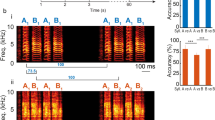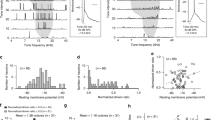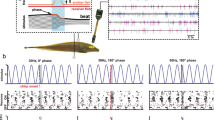Abstract
OSCILLATING membrane potentials that generate rhythmic impulse patterns are considered to be of particular significance for neuronal information processing1–4. In contrast, noise is usually seen as a disturbance which limits the accuracy of information transfer5–8. We show here, however, that noise in combination with intrinsic oscillations can provide neurons with particular encoding properties, a discovery we made when recording from single electrosensory afferent of a fish. The temporal sequence of the impulse trains indicates oscillations that operate near the spike-triggering threshold. The oscillation frequency determines the basic rhythm of impulse generation, but whether or not an impulse is actually triggered essentially depends on superimposed noise. The probability of impulse generation can be altered considerably by minor modifications of oscillation baseline and amplitude, which may underlie the exquisite sensitivity of these receptors to thermal and electrical stimuli. Additionally, thermal, but not electrical, stimuli alter the oscillation frequency, allowing dual sensory messages to be conveyed in a single spike train. These findings demonstrate novel properties of sensory transduction which may be relevant for neuronal signalling in general.
This is a preview of subscription content, access via your institution
Access options
Subscribe to this journal
Receive 51 print issues and online access
$199.00 per year
only $3.90 per issue
Buy this article
- Purchase on Springer Link
- Instant access to full article PDF
Prices may be subject to local taxes which are calculated during checkout
Similar content being viewed by others
References
Llinas, R. R. Science 242, 1654–1664 (1988).
Aldenhoff, J. B. Pharmacopsychiatry 22, 227–240 (1989).
Connors, W. B. & Gutnick, M. J. Trends neurol. Sci. 13, 99–104 (1990).
McGormick, D. A & Feeser, H. R. Neuroscience 39, 103–113 (1990).
Bullock, T. H. J. gen. Physlol. 55, 565–584 (1970).
Fitzhugh, R. J. gen. Physiol. 40, 675–692 (1958).
Schreiner R. C., Essick, G. K. & Whitsel, B. L. J. Neurophysiol. 41, 338–349 (1978).
Bialek, W. & Rieke, F. Trends neurol. Sci. 15, 428–435 (1992).
Iggo, A. J. Physiol., Lond. 200, 391–407 (1969).
Dykes, R. W. Brain Res. 98, 485–500 (1975).
Braun, H. A., Bade, H. & Hensel, H. Pflügers Arch. 386, 1–9 (1980).
Braun, H. A., Schäfer, K. & Wissing, H. in Thermoreception and Temperature Regulation (eds Bligh, J. & Voigt, K.) 19–29 (Springer, Berlin, 1990).
Schäfer, K., Braun, H. A. & Rempe, L. Experientia 47, 47–50 (1990).
Longtin, A., Bulsara, A. & Moss, F. Phys. Rev. Lett. 67, 656–659 (1991).
Maddox, J. Nature 325, 469 (1991).
Brink, F., Bronk, D. W. & Larrabee, M. G. Ann. N.Y. Acad. Sci. 47, 457–485 (1946).
Buller, A. J., Nicholls, J. G. & Ström, G. J. Physiol., Lond. 122, 409–418 (1953).
Braun, H. A., Schäfer, K., Wissing, H. & Hensel, H. in Sensory Receptor Mechanisms (eds Hamann, W. & Iggo, A.) 147–156 (World Science, Singapore, 1984).
Schäfer, K. & Braun, H. A. Pflügers Arch. 417, 91–99 (1991).
Sokabe, M. et al. J. Neumphysiol. 70, 275–283 (1993).
Knight, B. W. J. gen. Physiol. 59, 734–766 (1972).
Longtin, A. J. stat. Phys. 70, 309–327 (1993).
Douglass, J.K., Wilkens, L., Pantazelou, E. & Moss, F. Nature 365, 337–340 (1993).
Fohlmeister, J., Poppele, R. E. & Purple, R. L. J. Neurophysiol. 37, 1213–1227 (1974).
Waltman, B. Acta physiol. scand. 66, Suppl. 264, 1–60 (1966).
Kalmijn, A.J. Nature 212, 1232–1233 (1966).
Bromm, B., Hensel, H. J. & Nier, K. Experientia 31, 615–618 (1975).
Akoev, G. N. & Andrianov, G. N. Adv. physiol. Sci. 31, 57–73 (1980).
Alonso, A. & Klink, R. J. Neurophysiol. 70, 128–143 (1993).
Hensel, H. Z. vergl. Physiol. 37, 509–526 (1955).
Author information
Authors and Affiliations
Rights and permissions
About this article
Cite this article
Braun, H., Wissing, H., Schäfer, K. et al. Oscillation and noise determine signal transduction in shark multimodal sensory cells. Nature 367, 270–273 (1994). https://doi.org/10.1038/367270a0
Received:
Accepted:
Issue Date:
DOI: https://doi.org/10.1038/367270a0
This article is cited by
-
A discrete Huber-Braun neuron model: from nodal properties to network performance
Cognitive Neurodynamics (2023)
-
Nonlinear mechanism for the enhanced bursting activities induced by fast inhibitory autapse and reduced activities by fast excitatory autapse
Cognitive Neurodynamics (2023)
-
Obstacle induced spiral waves in a multilayered Huber-Braun (HB) neuron model
Cognitive Neurodynamics (2023)
-
Nonlinear mechanisms for opposite responses of bursting activities induced by inhibitory autapse with fast and slow time scale
Nonlinear Dynamics (2023)
-
The nonlinear mechanism for the same responses of neuronal bursting to opposite self-feedback modulations of autapse
Science China Technological Sciences (2021)
Comments
By submitting a comment you agree to abide by our Terms and Community Guidelines. If you find something abusive or that does not comply with our terms or guidelines please flag it as inappropriate.



